The Return of the Prodigal Son. Reflections Starting with the Picture by Rembrandt
Is it reasonable to produce an essay to outline analogies between ‘The Return of the Prodigal Son’ by Rembrandt and the practice of medicine? At the outset, we could argue that this Dutch painter was inspired by the three parables on mercy and forgiveness taught by Jesus but narrated only in the Gospel of Luke. In the gospel texts attributed to the other Evangelists, Matthew, Mark and John, no mention is made of this passage from the life of Christ. We may observe that Luke was a physician and was involved in proclaiming the activity of mercy and forgiveness of Jesus, especially for pagans – people who up to that moment had been excluded from the project of salvation. It appears that we have a good justification for addressing this challenge.
The ‘Return of the Prodigal Son’ is probably one of the last paintings by the Dutch master of the seventeenth century and it is exhibited at the Hermitage Museum of St. Petersburg in Russia. When purchasing an entrance ticket to a museum that is considered one of the most important in the world, the visitor already understands the importance of this masterpiece because the ticket has a picture of the work in question. More than any other painter, Rembrandt saw his pictorial art as guided by a wish to involve the observer in an environment of great emotion. In establishing as a priority in the mission of Christ the welcoming of the most vulnerable, Luke the Evangelist made use of his knowledge as a physician who was used to being with people who were weakened by the illnesses of that epoch. This is the reason why the honour of being the patron saint of medicine was bestowed upon him.
The parable of the prodigal son and the two parables that precede it in the Gospel of Luke, the parable of the lost sheep and the parable of the lost drachma, constitute a special context by which to reveal the magnanimity of the love of God, His unconditional welcoming of sinners who seek forgiveness, and care for spiritual health, a pathway that is similar to that of patients who seek to cure their physical illnesses through medical treatment.
The text of Luke (15:11-32) employs three iconic characters: the father, the younger son (the ‘prodigal son’), and the older son (who remained with his father on the family property). The younger son, who is repentant and returns to his father’s house after wasting all of his inheritance on a dissolute life, prostrates himself in front of his father and asks him for forgiveness and to be welcomed. His father, moved by pity, exults at the return of his son who was lost and accepts him with a warm and noble welcome. In the description given by the Evangelist, the older son was in the field at the moment of the meeting of his father with his brother who had returned. Luke says: ‘And as he came and drew near to the house, he heard music and dancing…But he was angry and refused to go in’.
Why was it that Rembrandt, in opposition to the holy text, painted the brothers together at that moment of great excitement? In beholding the masterpiece of the Dutch master, we can imagine the possible intentions of the painter. We will look, therefore, for the details that reveal the emotions that dominate each of the three human figures painted by the artist. First, however, we should emphasise the importance of the light around the characters painted by Rembrandt, a resource often used to guide the eye of the observer towards the prominent points of the greater drama projected onto the screen of the canvas.
Many experts, faced with the emotions provoked by looking at famous paintings, often use the phrase ‘this canvas speaks for itself’. The ‘Return of the Prodigal Son’ by Rembrandt, in my view, is one of the greatest and richest examples of this perception of the great experts of the fine arts. Consider the following: the figure of the older brother, surrounded by the same rich gown that covers the back of his father, reveals his status of nobility or, to put it better, his personality which has shared in the wealth of his father and the comfort of his house, both of which experienced with the haughty dignity of the first born, the heir to his father’s fortune, showing that he is able to command and be obeyed by his subordinates.
Message of his Holiness Francis for World Mission Day 2019
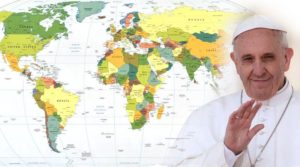 Baptized and Sent: The Church of Christ on Mission in the World
Baptized and Sent: The Church of Christ on Mission in the World
Dear Brothers and Sisters,For the month of October 2019, I have asked that the whole Church revive her missionary awareness and commitment as we commemorate the centenary of the Apostolic Letter Maximum Illud of Pope Benedict XV (30 November 1919). Its farsighted and prophetic vision of the apostolate has made me realize once again the importance of renewing the Church’s missionary commitment and giving fresh evangelical impulse to her work of preaching and bringing to the world the salvation of Jesus Christ, who died and rose again.The title of the present Message is the same as that of October’s Missionary Month: Baptized and Sent: The Church of Christ on Mission in the World. Celebrating this month will help us first to rediscover the missionary dimension of our faith in Jesus Christ, a faith graciously bestowed on us in baptism. Our filial relationship with God is not something simply private, but always in relation to the Church. Through our communion with God, Father, Son and Holy Spirit, we, together with so many of our other brothers and sisters, are born to new life. This divine life is not a product for sale – we do not practise proselytism – but a treasure to be given, communicated and proclaimed: that is the meaning of mission. We received this gift freely and we share it freely (cf. Mt 10:8), without excluding anyone. God wills that all people be saved by coming to know the truth and experiencing his mercy through the ministry of the Church, the universal sacrament of salvation (cf. 1 Tim 2:4; Lumen Gentium, 48).
DELEGAZIONE IN TANZANIA
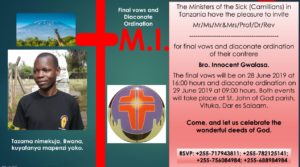 Il 29 giugno 2019 il confratello Innocent Gwalasa riceverà l’ordinazione diaconale presso la parrocchia St. John of God, Vituka, Dar es Salaam.
Il 29 giugno 2019 il confratello Innocent Gwalasa riceverà l’ordinazione diaconale presso la parrocchia St. John of God, Vituka, Dar es Salaam.
THE PROVINCE OF ROME
 Father Germano Santone, a Camillian religious and a chaplain at St. John’s Hospital of Rome, in the studios of TV2000 (the television channel of the Italian bishops) described a young Camillian for whom the cause of beatification is now underway – Nicola D’Onofrio. With him in the studios was also Virginia D’Onofrio, a niece of this Venerable. CLICK HERE
Father Germano Santone, a Camillian religious and a chaplain at St. John’s Hospital of Rome, in the studios of TV2000 (the television channel of the Italian bishops) described a young Camillian for whom the cause of beatification is now underway – Nicola D’Onofrio. With him in the studios was also Virginia D’Onofrio, a niece of this Venerable. CLICK HERE
THE PROVINCE OF SPAIN
 José Carlos Bermejo, a Camillian religious and the director of the Centro de Humanización de la Salud of Tres Cantos (Madrid), has received an honorary prize for the ‘Best Professional Career Connected with Health’. Janssen, in collaboration with Cátedras en Red, presented the fifth edition of the Albert Jovell Awards with prizes to projects that improve the results of care in patients and stand out because of their innovative character and humanistic approach.
José Carlos Bermejo, a Camillian religious and the director of the Centro de Humanización de la Salud of Tres Cantos (Madrid), has received an honorary prize for the ‘Best Professional Career Connected with Health’. Janssen, in collaboration with Cátedras en Red, presented the fifth edition of the Albert Jovell Awards with prizes to projects that improve the results of care in patients and stand out because of their innovative character and humanistic approach.
‘San Camilo y sus Ministros de los Enfermos’
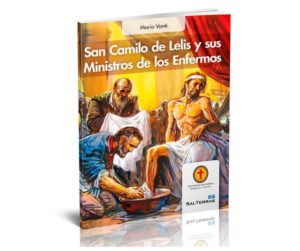 The publishing house La sal Terrae has just published the Spanish edition of the life of St. Camillus de Lellis by Mario Vanti: San Camilo e i suoi ministri degli infermi (‘St. Camillus and his Ministers of the Sick’).
The publishing house La sal Terrae has just published the Spanish edition of the life of St. Camillus de Lellis by Mario Vanti: San Camilo e i suoi ministri degli infermi (‘St. Camillus and his Ministers of the Sick’).
‘This is one of the most important books there is on St. Camillus. One need only turn to the elderly religious of the Order to hear that all of them refer to ‘Vanti’ as one of the most important reference points to understand the figure of Camillus: an extraordinary source to know about this humanising reformer of the sixteenth century.
‘The Province of Spain is happy to translate it, certain that it has made a major contribution to all those who draw near to this great figure. This has been an essential operation for Camillian religious and positive for all those who want to know about the history of charity in the world of health and human suffering’. These are the words of José Carlos Bermejo, the Delegate General of the Camillian religious of Spain, and are to be found in the preface to this new edition.
This publication has nine chapters in which Fr. Mario Vanti describes in detail the life of the ‘Saint of Charity’ and the beginnings of the Order that he founded.
Father Salvatore Pontillo, a Camillian religious of the Province of Sicily and Naples, on 20 June 2019 was awarded a licence in the theology of consecrated life by the Claretianum Theological College of Rome. His thesis was entitled ‘The Fourth Camillian Vow: Roots, History, Theology, Testimonies and Future Prospects’ – summa cum laude! Congratulations!
The women Ministers of the Sick of St. Camillus have announced the death of Sr. Fe Santos. This took place on 19 June 2019 at the community of the Delegation in the Philippines. Sr. Fe was sixty-seven years old. She made her religious profession on 25 March 1985.
THE PROVINCE OF SICILY AND NAPLES
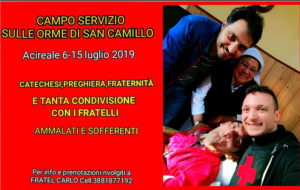 A camp, involving service, for vocational discernment for young men will be held in Acireale. These days will be marked by moments of prayer, catechesis, fraternity and a very great deal of service with our sick and suffering brothers and sisters. This initiative forms a part of the celebrations for the feast day of St. Camillus de Lellis in Acireale. CLICK HERE
A camp, involving service, for vocational discernment for young men will be held in Acireale. These days will be marked by moments of prayer, catechesis, fraternity and a very great deal of service with our sick and suffering brothers and sisters. This initiative forms a part of the celebrations for the feast day of St. Camillus de Lellis in Acireale. CLICK HERE
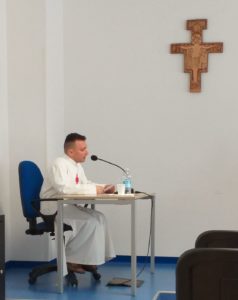 Padre Salvatore Pontillo, religioso camilliano della provincia sicula-napoletana, il giorno 20 giugno 2019 ha conseguito la licenza in teologia della vita consacrata presso l’istituto teologico Claretianum di Roma con una tesi dal titolo “Il quarto voto camilliano: radici, storia, teologia, testimonianze e prospettiva futura” …summa cum laude! Congratulazioni
Padre Salvatore Pontillo, religioso camilliano della provincia sicula-napoletana, il giorno 20 giugno 2019 ha conseguito la licenza in teologia della vita consacrata presso l’istituto teologico Claretianum di Roma con una tesi dal titolo “Il quarto voto camilliano: radici, storia, teologia, testimonianze e prospettiva futura” …summa cum laude! Congratulazioni
AND I AM COMING TO LOOK FOR YOU …
Reflections on the recent Camillian Parish Mission in Mondragone (Caserta)
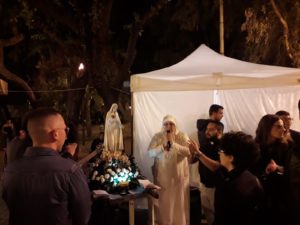 By Luca Caiazzo, a young man and local journalist
By Luca Caiazzo, a young man and local journalist
In Mondragone young people of the parishes and Camillian missionaries immersed amongst the young: the ‘outward-going Church’ mission.
11 May 2019 22.00 SAVE THE DATE’: a leaflet in a style for young people had been circulating amongst young people who frequented the nightlife of Mondragone. It had logos that evoked the invitations to evenings of music in bars, from the town villa to the pier and on to a part of the waterfront. It had been circulating for a week, almost without provoking a reaction, because in its title there were symbols that refer to ‘other entities’, things called a ‘vicariate’ or a ‘diocese’. To sum up: things to do with the Church. But there are sentences that at a certain moment and in certain places can become sharp blades. The title of a song by Battiato suggests this: ‘and I am coming to look for you’. The idea of parish priests and of the vicar of the vicariate, Don Nando Iannotta, in this initiative young people of the parishes, helped by the presence of Camillian missionaries involved in Mondragone in an inter-parish mission for the sick and the infirm, went for a week to distribute leaflets and then, strongly equipped with a monstrance and a statue of the Virgin Mary, stood in a gazebo/tent with the stimulating provocation: ‘Jesus is here; he is looking for you; he wants to talk to you; he is really listening to you!’
Life: a gift received to be offered – Inauguration of the ‘House of Charity’
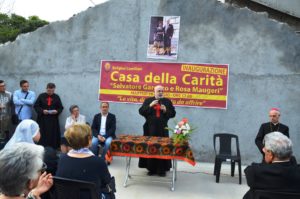 The inauguration took place on Tuesday 28 May 2019 of the ‘House of Charity’, a new Camillian work in the territory of Acireale, the neighbourhood of San Giovanni Bosco, in Via Nazionale per Guardia, number 26. This house derives from a donation made by an elderly gentleman who died in 2014 and wanted to give his house to help poor people and the abandoned elderly, naming it after himself and his deceased wife.
The inauguration took place on Tuesday 28 May 2019 of the ‘House of Charity’, a new Camillian work in the territory of Acireale, the neighbourhood of San Giovanni Bosco, in Via Nazionale per Guardia, number 26. This house derives from a donation made by an elderly gentleman who died in 2014 and wanted to give his house to help poor people and the abandoned elderly, naming it after himself and his deceased wife.
THE PROVINCE OF NORTH ITALY
Celebration of the Camillian Fraternity of Casale Monferrato, Tuesday 18 June 2019 – The religious were at Casale from 1829 to 1989
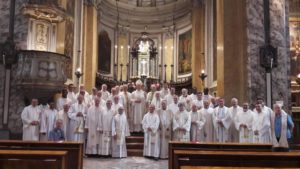 On Tuesday 18 June 2019, in the Church of St. Paul, the annual meeting will take place of the fraternity of the Camillian fathers. For the first time this will be held in Piedmont. This choice has its justification. The aim is to strengthen the relationships of the religious of the new Province of North Italy. In truth, the exchanges between the religious of Piedmont and the religious of Lombardy and Veneto have always been frequent and affable. In addition, the choice of the house of Casale was made to evoke a page of its history and to remember, in particular, the birth of the Province of Piedmont.
On Tuesday 18 June 2019, in the Church of St. Paul, the annual meeting will take place of the fraternity of the Camillian fathers. For the first time this will be held in Piedmont. This choice has its justification. The aim is to strengthen the relationships of the religious of the new Province of North Italy. In truth, the exchanges between the religious of Piedmont and the religious of Lombardy and Veneto have always been frequent and affable. In addition, the choice of the house of Casale was made to evoke a page of its history and to remember, in particular, the birth of the Province of Piedmont.
The decree on its erection was signed on 28 August 1834 by Cardinal Giuseppe Morozzo Della Rocca, the Bishop of Novara and the Apostolic Visitor and Delegate for all the regular Orders that existed in the Kingdom of Sardinia. The house of Casale played an important role. It was the point of reference for the creation of the autonomous Province, something strongly wished for by Cardinal Morozzo himself.
CONTINUE READING HERE.
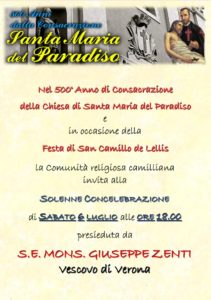 On Saturday 6 July, at 18.00, on the occasion of the annual feast day of St. Camillus de Lellis, the five hundredth anniversary of the consecration of the Church of St. Mary of Heaven in Verona will be celebrated. Msgr. Giuseppe Zenti, the Bishop of Verona, will preside over the celebration of the Eucharist.
On Saturday 6 July, at 18.00, on the occasion of the annual feast day of St. Camillus de Lellis, the five hundredth anniversary of the consecration of the Church of St. Mary of Heaven in Verona will be celebrated. Msgr. Giuseppe Zenti, the Bishop of Verona, will preside over the celebration of the Eucharist.
On 2-17 July 2019, at Capriate San Gervasio (BG), a summer event for young people will be organised: service, prayer and fraternity.
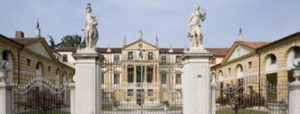 The spiritual exercises of the Province of 16-20 September 2019 will be preached by the biblical scholar and expert on the Holy Land, Father Fernando Armellini (Dehonian). Their subject will be: ‘The New Justice of the Kingdom of God’. This is the new justice that St. Camillus welcomed into his life after his conversion.
The spiritual exercises of the Province of 16-20 September 2019 will be preached by the biblical scholar and expert on the Holy Land, Father Fernando Armellini (Dehonian). Their subject will be: ‘The New Justice of the Kingdom of God’. This is the new justice that St. Camillus welcomed into his life after his conversion.
THE DELEGATION OF HAITI
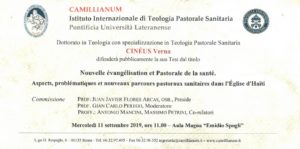 On 11 September 2019 our confrere Verna Cinéus will discuss his doctoral thesis in the theology of pastoral care in health at the Camillianum of Rome. The title of his dissertation is ‘Nouvelle évangélisation et Pastorale de la santé. Aspects, problématiques et nouveaux parcours pastoraux sanitaires dans l’église d’Haiti’.
On 11 September 2019 our confrere Verna Cinéus will discuss his doctoral thesis in the theology of pastoral care in health at the Camillianum of Rome. The title of his dissertation is ‘Nouvelle évangélisation et Pastorale de la santé. Aspects, problématiques et nouveaux parcours pastoraux sanitaires dans l’église d’Haiti’.
DAUGHTERS OF ST. CAMILLUS
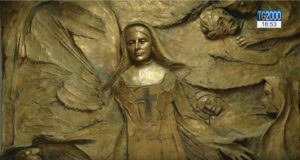 Pope Francis has promulgated the decree on the miracle of the Blessed Giuseppina Vannini
Pope Francis has promulgated the decree on the miracle of the Blessed Giuseppina Vannini
On 13 May 2019 the Holy Father Francis received in audience His Most Reverend Eminence Cardinal Angelo Becciu, the Prefect of the Congregation of the Causes of Saints. During the audience the Supreme Pontiff authorised this Congregation to promulgate the decree on the miracle attributed to the intercession of the Blessed Giuseppina Vannini (born Giuditta Adelaide Agata), the founder of the Daughters of St. Camillus. She was born in Rome (Italy) on 7 July 1859 and died in Rome on 23 February 1911.
MOTHER GIUSEPPINA VANNINI WILL BE A SAINT. THE WORDS OF THE POSTULATOR
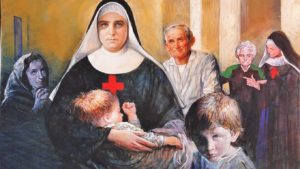 The Congregation of the Causes of Saints has been authorised by the Pope to promulgate the decree on the miracle attributed to the intercession of the Blessed Giuseppina Vannini. The founder of the Daughters of St. Camillus will soon be a saint. She was born in the second half of the nineteenth century in Rome where there is now a hospital that bears her name. Article by Francesco Durante
The Congregation of the Causes of Saints has been authorised by the Pope to promulgate the decree on the miracle attributed to the intercession of the Blessed Giuseppina Vannini. The founder of the Daughters of St. Camillus will soon be a saint. She was born in the second half of the nineteenth century in Rome where there is now a hospital that bears her name. Article by Francesco Durante
PUBLISHING NEWS
The Camillians in Pavia since 1693 at the service of the sick
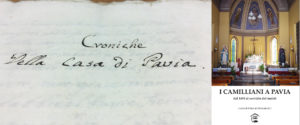 Edited by Felice de Miranda M.I., I Camilliani a Pavia dal 1693 al servizio dei malati, Edizioni CDG, 2019
Edited by Felice de Miranda M.I., I Camilliani a Pavia dal 1693 al servizio dei malati, Edizioni CDG, 2019
DOWNLOAD HERE THE TEXT IN FORMAT PDF
Preface by Fr. Mario Bizzotto, M.I.
Looking back at the past can only be edifying. It is a way of filling in the present by filling in emptiness. What would the present be without the past? Would it not lose its meaning? An answer to this question is provided by the initiative of Father De Miranda who had the happy idea of making a summary of the activity of the Camillian fathers in St. Matthew’s Hospital of Pavia. He describes to us a past that starts in faraway 1692 and continues until 1810 when, following the Napoleonic laws, the Camillian religious were forced to abandon their ministry at the service of the sick in the city of Pavia.
The ideal of St. Camillus found disciples who followed one another like rings in a chain. A long tradition thereby came to be established which it would be ungrateful to allow to be forgotten.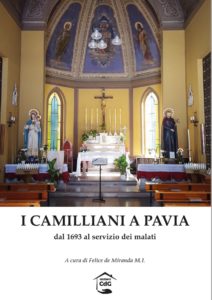 Indeed, that would be a betrayal of identity. The Jewish thinker Adorno defined forgetting as diabolical and identified it with Satan. There is also a duty to remember and to betray this duty means that we make ourselves responsible for a sin. In Holy Scripture we repeatedly encounter a warning that has the value of a command: remember your mother and father, remember to sanctify holy days…
Indeed, that would be a betrayal of identity. The Jewish thinker Adorno defined forgetting as diabolical and identified it with Satan. There is also a duty to remember and to betray this duty means that we make ourselves responsible for a sin. In Holy Scripture we repeatedly encounter a warning that has the value of a command: remember your mother and father, remember to sanctify holy days…
The editor of this work, Fr. De Miranda, observes that his work is intended for the citizens of Pavia. In fact, however, it is principally of interest to the Camillians. In essential terms, we have here a history that belongs to our family; to the ‘little plant’ that St. Camillus said would spread. It put down roots in Pavia as well. There were no special initiatives, which for that matter were not even necessary given that care for the sick takes place through small pathways, gestures that do not stand out, words of encouragement and cordial handshakes. This care is averse to amazing outward expressions. It unfolds in inter-personal relationships and thus by its very nature it is humble, ferial, unadorned; it expresses itself in contacts with an individual and in encounter with an individual, where it is possible to listen to things spoken confidentially, personal histories, and autobiographical stories that for the most part are marked by sad events.
Yelyaore Lazare – Santé et développement
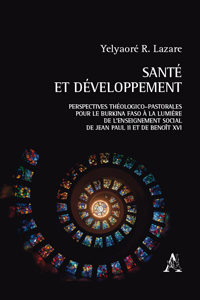 SANTÉ ET DÉVELOPPEMENT. PERSPECTIVES THÉOLOGICO-PASTORALES POUR LE BURKINA FASO À LA LUMIÈRE DE L’ENSEIGNEMENT SOCIAL DE JEAN PAUL II ET DE BENOÎT XVI – by Fr. Yelyaore Lazare
SANTÉ ET DÉVELOPPEMENT. PERSPECTIVES THÉOLOGICO-PASTORALES POUR LE BURKINA FASO À LA LUMIÈRE DE L’ENSEIGNEMENT SOCIAL DE JEAN PAUL II ET DE BENOÎT XVI – by Fr. Yelyaore Lazare
The antagonism between health and development – which characterises low-income countries – is usually translated into inappropriate health-care policies and lifestyles. However, an existential, historical and in particular theological-pastoral approach highlights shared points in the health/development tandem. The human person himself, in his uniqueness and in his plural expression, is the foundation, the measurement and the destination of every search for health and development. Health, therefore, cannot exclude development without betraying itself and without betraying man. The call to life and to complete fulfilment (holiness) includes the call to health and integral development. This is a vocation that is a part of a process that involves the responsibility of man and obliges him to give a response of high quality that should be translated into charity in all contexts – personal life, professional life, family life and social life. Health and development become a hermeneutical key by which to read, interpret and actualise the diaconal mission of the Church, which is a response of love to the call of God.
THE VICE-PROVINCE OF BENIN TOGO
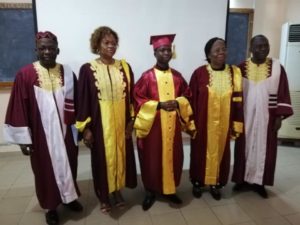 Congratulations to our confrere Father Urlch who was awarded a degree in medicine and surgery at the University of Cotonou (Benin-Togo). A great gift for the Camillian Province of Benin-Togo!
Congratulations to our confrere Father Urlch who was awarded a degree in medicine and surgery at the University of Cotonou (Benin-Togo). A great gift for the Camillian Province of Benin-Togo!
THE CHURCH OF ST. MARY MAGDALENE OF ROME
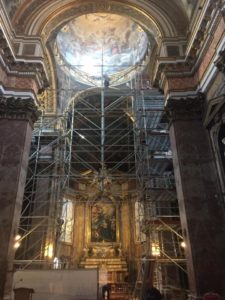 On 2 May 2019 the much ‘yearned for’ building site was opened for the restoration and above all the structural strengthening of the bell tower of our ‘Church of St. Mary Magdalene’ in Rome.
On 2 May 2019 the much ‘yearned for’ building site was opened for the restoration and above all the structural strengthening of the bell tower of our ‘Church of St. Mary Magdalene’ in Rome.
The historic cracks in the bell tower which increased with the shocks from the earthquakes of recent years – devastating earthquakes in central Italy that were felt in Rome, above all in our neighbourhood of ‘Campo Marzio’ which notoriously is an ancient marshy area and traversed by many streams that flow into the Tiber – had begun to provoke a certain concern.
With a certain satisfaction, at the beginning of the month of June 2019 a large building site was installed (41 metres high) that was also inside the Church of St. Mary Magdalene for the restoration of the fresco of the Trinity that adorns the cupola (1739), the work of the painter Parrocel (Parosel) Stefano (Avignon, January 1696-Rome, 26 August or 13 January 1775 or 1776), known as Le Romain. The restoration of the cupola envisages technical intervention for cracks and fissures and the replacement of the oculi of the cupola and the windows of the small lantern.
In a few days time the building site for the scaffolding for the strengthening and restoration of the facade of the church of St. Mary Magdalene will also begin. The baroque facade of our church is the work of the architect Giuseppe Sardi (Sant’Angelo in Vado, 1680-Rome, 1753). He was the creator of the facade of the Church of St. Mary Magdalene in Rome between 1716 and 1718 and he received a commission to do this from Cardinal Annibale Albani. The Church of St. Mary Magdalene was this Cardinal’s titular church.
The financial support of the ‘owner’ – the F.E.C., the Fund for the Buildings of Worship, the Ministry for Internal Affairs; the technical and legal perseverance of the Special Superintendence for the Architectural Heritage of Rome; and the kind readiness to help of the members of the building complex have all contributed to this undertaking.
The hope is that a long-lasting maintenance will be achieved.
THE FEAST DAY OF ST. CAMILLUS DE LELLIS – 14 July 2019
The Church of ‘St. Mary Magdalene’ – Rome
On Thursday 11 July to Friday 12 July 2019, at 20.000: the rosary, a reading of some writings of St. Camillus, the Sacrament of Reconciliation, and a visit to the ‘Cubiculum’.
Saturday 13 July, at 20.00 – prayer vigil
THE FEAST DAY OF ST. CAMILLUS
Sunday 14 July 2019, at 11.30
A solemn celebration of the Eucharist presided over by His Excellency Msgr. Gianrico RUZZA, the Auxiliary Bishop of the Diocese of Rome.
THE GENERAL CONSULTA – NEW ADMISSIONS TO PERPETUAL PROFESSION
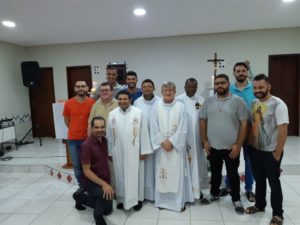 Fr. Laurent Zoungrana, the Vicar General of the Order, and Br. José Ignacio Santaolalla, a member of the General Consulta, visited the Camillian communities in Brazil during the month of May 2019.
Fr. Laurent Zoungrana, the Vicar General of the Order, and Br. José Ignacio Santaolalla, a member of the General Consulta, visited the Camillian communities in Brazil during the month of May 2019.
READ HERE THE MESSAGE TO THE PROVINCE OF BRAZIL at the end of the visit.
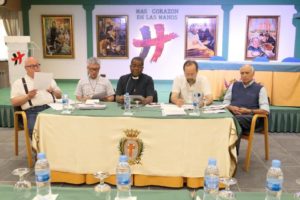 On 13-23 June 2019 Fr. Laurent Zoungrana, the Vicar General and the member of the General Consulta responsible for formation, met the religious of the Province of Spain during the customary pastoral visit.
On 13-23 June 2019 Fr. Laurent Zoungrana, the Vicar General and the member of the General Consulta responsible for formation, met the religious of the Province of Spain during the customary pastoral visit.
During these ten days the religious of the Province received this visit with great enthusiasm and this demonstrates the wish for fraternity and brotherhood in the Order. The religious showed to the General Consulta the pathways of the works that they place at the service of sick and suffering people in their Province.
Here is the programme of the meetings
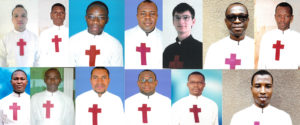 The General Consulta has admitted to perpetual profession thirteen young temporary professed:
The General Consulta has admitted to perpetual profession thirteen young temporary professed:
- Lasha Manukian (the Province of Poland – Georgia)
- Mensianus Aman (the Province of the Philippines – Indonesia)
- Webly Lagrenade (the Province of North Italy – the Delegation in Haiti)
- Jean Charles Maxo (the Province of North Italy – the Delegation in Haiti)
- Jean James (the Province of North Italy – the Delegation in Haiti)
- Guilaire Joubency Blaise (the Province of North Italy – the Delegation in Haiti)
- Bawaya Aristide Michael Kéré (the Province of Burkina Faso)
- Relwende Pierre Marie Savadogo (the Province of Burkina Faso)
- Ramakwende Hugues Bertrand Djiguemde (the Province of Burkina Faso)
- Eric Wendkouni Ouedraogo (the Province of Burkina Faso)
- Kayaba Apolinaire Giuguemde (the Province of Burkina Faso)
- Stephane Malgoubri (the Province of Burkina Faso)
- Sandaogo Seraphin Bougouma (the Province of Burkina Faso)
THE REVIEW CAMILLIANI/CAMILLIANS
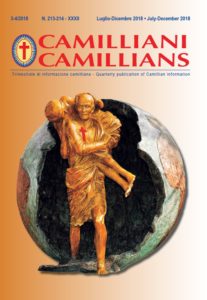 It is possible to download online the new number of the review Camilliani/Camillians – DOWNLOAD THE PDF HERE
It is possible to download online the new number of the review Camilliani/Camillians – DOWNLOAD THE PDF HERE
MEETING OF THE ADMINISTRATORS AND DIRECTORS OF CAMILLIAN WORKS
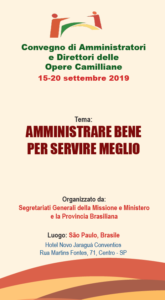 A meeting of the administrators and directors of Camillian works on the subject ‘ADMINISTER WELL TO SERVE BETTER’ has been organised by the General Secretariat for Mission and the General Secretariat for Ministry, as well as the Camillian Province of Brazil. It will be held in São Paulo (Brazil) on 5-20 September 2019.
A meeting of the administrators and directors of Camillian works on the subject ‘ADMINISTER WELL TO SERVE BETTER’ has been organised by the General Secretariat for Mission and the General Secretariat for Ministry, as well as the Camillian Province of Brazil. It will be held in São Paulo (Brazil) on 5-20 September 2019.
FROM OUR GENERAL ARCHIVES – fragments of Camillian history
THE MARTYRS TO CHARITY Fr. Giacomo Giacopetti – a great Teacher, a great Disciple
This year, the twenty-fifth anniversary of the establishment of the day of martyrs to charity, we want to remember one of the most representative Martyrs to Charity of the Order of Camillians: Br. Giacomo Giacopetti.
Birth and upbringing
Giacomo Giacopetti was born on 25 November 1591 in Ripatransone, a small town in the Province of Ascoli Piceno, to his father Francesco and his mother Emilia Guerrieri. His mother played an important role in his early upbringing and instilled in the young Giacomo love for God, devotion to Mary, feelings of piety and a horror of sin. His uncle, Pietro Arrico Giacopetti, who was an archpriest and a canon of the cathedral, also played an important role in his early life and perceived in him uncommon talents. He taught him the divine offices and the solemnities of the Church and introduced him to the study of the humanities and the sciences, filling him with a love for music.
Very soon Giacomo, of all the scientific disciplines, showed a special propensity and aptitude for the health-giving art of medicine to which was joined his natural vocation to strive for the wellbeing of the poorest and those most in need – a vocation that grew in him and developed with age. As a result he soon asked, and permission was given to him by his parents to do this, to go to Rome to the Hospital of the Holy Spirit in Sassia in order to put his studies into practice under the direction of the able medical doctors who worked in that hospital. Moreover, another uncle on his father’s side, Michele Giacopetti, was a canon and prior at the same hospital.
After arriving in Rome in 1608 he applied himself to the study and practice of medicine with seriousness and passion and he became in a short period of time an able physician. Chance had it that in that same period there also worked at the Hospital of the Holy Spirit in Sassia Father Camillus de Lellis himself who after abandoning the generalate and the government of the Order that he had founded had asked for, and obtained, permission to care for the sick, night and day. In Giacomo Giacopetti, because of the example of Fr. Camillus, his vocation grew.
DECEASED RELIGIOUS
See, now they vanish, the faces and places, with the self which, as it could, loved them. To become renewed, transfigured, in another pattern’ (T.S. Eliot).
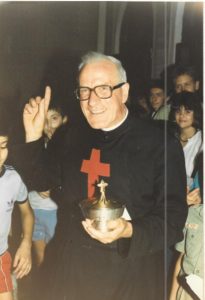 The Camillian religious of the Province of Rome announce the death of their Camillian confrere Fr. GIACOMO MESCHINI (at the age of 95).
The Camillian religious of the Province of Rome announce the death of their Camillian confrere Fr. GIACOMO MESCHINI (at the age of 95).
His death took place on 21 June 2019 at the Camillian community of Bucchianico.
Let us remember Fr. Giacomo in our prayers! READ HERE
‘Now they live in Christ whom they met in the Church, followed in our vocation, and served in the sick and the suffering. Trusting that the Lord, the Holy Virgin our Queen, St. Camillus, the Blessed Luigi Tezza, the Blessed Giuseppina Vannini, and our deceased religious brothers and sisters, will welcome them in their midst, we commend them in our prayers, remembering them with affection, esteem and gratitude’.
VATICAN CITY
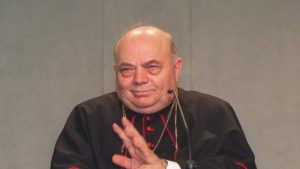 Adieu to Cardinal Elio Sgreccia, one of the greatest experts on bioethics in the world
Adieu to Cardinal Elio Sgreccia, one of the greatest experts on bioethics in the world
The President-Emeritus of the Pontifical Academy for Life would have celebrated his ninety-first birthday tomorrow. The Pope praises his ‘precious and active work in defence of the fundamental value of human life’.
He was a theologian, the President-Emeritus of the Pontifical Academy for Life, and one of the points of reference in the Catholic world for questions connected with bioethics.
PRAYER FOR THE VICTIMS OF ALL TYPES OF DISASTERS – CADIS
 For all the victims of all types of disasters, for people who have lost their lives, for their loved ones, for the survivors, and for all those who work to provide help, we pray: God in heaven, who has created and who preserves every existence, you know all of our sadness and our suffering. May all the victims of all types of disasters be welcomed in your peace! Receive, we pray, in your mercy, our very many brothers and sisters buried by the forces unleashed by nature. Lead them to your home! Comfort the pain of so many families, dry the tears of so many brothers and sisters, offer protection to the loneliness of so many orphans. Instil courage into everyone so that pain is transformed into a journey of growth and hope. Generate in the hearts of Christians and all men and women of good will the wish to act so that the wounded and those who suffer because of these calamities experience the comfort of fraternal solidarity. You who live and reign for ever and ever. Amen. Our Father – Hail Mary – Glory.
For all the victims of all types of disasters, for people who have lost their lives, for their loved ones, for the survivors, and for all those who work to provide help, we pray: God in heaven, who has created and who preserves every existence, you know all of our sadness and our suffering. May all the victims of all types of disasters be welcomed in your peace! Receive, we pray, in your mercy, our very many brothers and sisters buried by the forces unleashed by nature. Lead them to your home! Comfort the pain of so many families, dry the tears of so many brothers and sisters, offer protection to the loneliness of so many orphans. Instil courage into everyone so that pain is transformed into a journey of growth and hope. Generate in the hearts of Christians and all men and women of good will the wish to act so that the wounded and those who suffer because of these calamities experience the comfort of fraternal solidarity. You who live and reign for ever and ever. Amen. Our Father – Hail Mary – Glory.



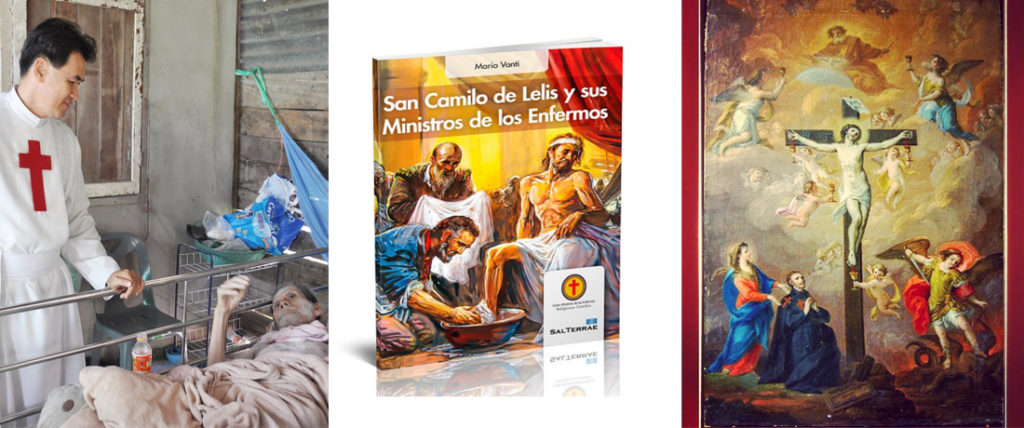
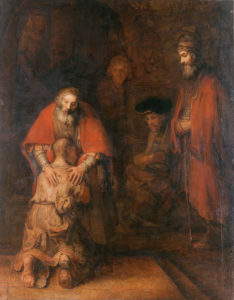
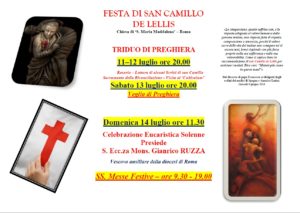
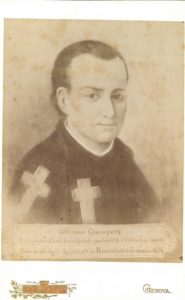

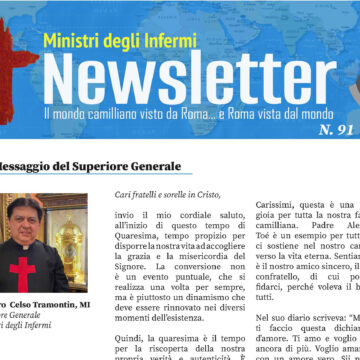










Camillians on Facebook
Camillians on Twitter
Camillians on Instagram